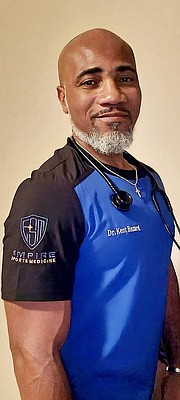By Kent Bazard
LAST week we had an introduction to the role and function of the sports medicine physician. This week let’s dive right into the deep end and take a swing at the most common injury in all running sports - hamstring injuries.
As a sports medicine physician deeply committed to understanding and managing injuries in track and field athletes, I have devoted significant research to unravelling the complexities of hamstring injuries.
Hamstring strains and tears pose substantial challenges to athletes, necessitating comprehensive insights into their anatomy, pathophysiology, and biomechanics.
Let’s take a small look at the intricate interplay of these factors to shed light on the prevention, diagnosis and management of hamstring injuries in the dynamic world of track and field.
The hamstring muscle group, located at the back of the thigh, consists of three primary muscles - the biceps femoris, semitendinosus and semimembranosus. These muscles play a pivotal role in hip extension and knee flexion, vital movements involved in running, jumping and hurdling in track and field events.
The biceps femoris is further divided into a long head and short head, creating a unique dynamic within the muscle group.
The tendons of these muscles converge and attach to the ischial tuberosity of the pelvis, forming the proximal hamstring complex, while their distal attachments merge to the tibia and fibula. Hamstring injuries in track and field often occur during high-intensity activities that require explosive acceleration, deceleration, and quick changes in direction. The eccentric nature of these movements, such as during the terminal swing phase of running or hurdling, can lead to overstretching and microtrauma within the hamstring muscles. The biceps femoris, particularly the long head, is more susceptible to injury due to its anatomical position, exhibiting higher rates of strain when compared to the semitendinosus and semimembranosus muscles.
Understanding the biomechanics of hamstring injuries is vital in designing effective prevention and rehabilitation strategies. The late swing phase of running, wherein the hip is flexed and the knee is extended, places significant strain on the hamstrings. Additionally, inadequate eccentric hamstring strength during the initial contact and swing phase of the gait cycle can exacerbate the risk of injury.
Athletes with muscle imbalances, reduced flexibility, and altered running mechanics are more susceptible to hamstring injuries.
As a Sports Medicine Physician, my focus is on a proactive approach to prevent hamstring injuries.
Biomechanical analysis and gait assessments can identify athletes’ risk factors, allowing for targeted interventions to correct muscle imbalances and optimize running mechanics. Incorporating eccentric hamstring strengthening exercises, such as Nordic hamstring curls, into training regimens is paramount in reducing the risk of hamstring injuries.
In the event of a hamstring injury, prompt diagnosis and individualized rehabilitation are essential.
Diagnostic imaging, such as magnetic resonance imaging (MRI), can accurately assess the severity of the injury, informing treatment planning. Rehabilitation programs should emphasize eccentric strengthening, flexibility exercises, and progressive return-to-play protocols. Collaborative care among sports medicine practitioners, physical therapists, and athletic trainers ensures comprehensive support for athletes on their road to recovery.
Understanding the intricacies of hamstring anatomy, pathophysiology, and biomechanics is fundamental in addressing the challenges posed by injuries in track and field. Through evidence-based prevention and management strategies, we can create a safer and more resilient track and field community, celebrating the triumphs of athletes as they strike a balance between pushing their limits and safeguarding their well-being.
Dr. Kent Bazard, is a Bahamian Sports Medicine Physician, Sports Performance Coach Sports Nutrition Specialist, and Founder of Empire Sports Medicine. Our mission is to empower athletes to reach new heights while safeguarding their health and well-being. We understand the unique demands of sports activities, and we are dedicated to helping athletes prevent injuries, overcome challenges, optimize nutrition and performance.





Comments
Use the comment form below to begin a discussion about this content.
Sign in to comment
Or login with:
OpenID